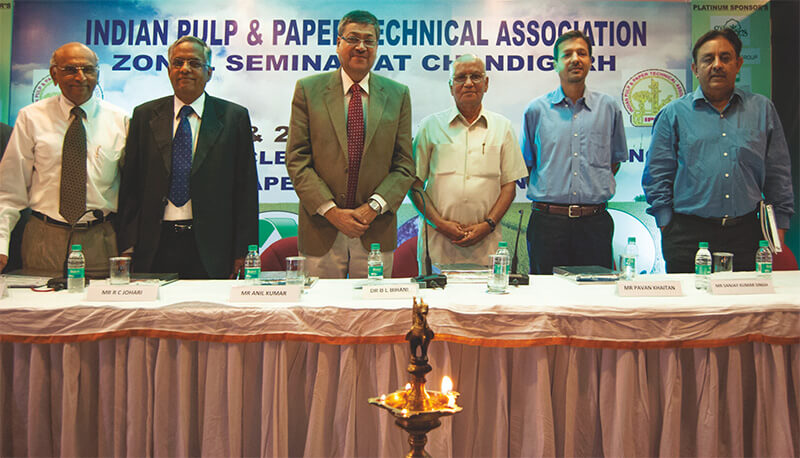
The seminar with the theme “Agro & Recycled Fiber Pulping, Bleaching and Paper & Board Making” was organized by IPPTA in Chandigarh in July 2012. The event started with the synopsis of Indian paper industry given by the President of IPPTA – Mr. M.B.S Nair followed by the inaugural address by chief guest Mr. A.R. Talwar, IAS. Later the panel discussion was organized where the topics related to agro and recycled paper mills were discussed. The panelist deliberated on different issues like raw material, energy & water consumption, environmental sustainability and the ways of improving through the use of technology etc.
.

The Indian paper industry is expected to grow at the GDP rate of 6-7%. In the last couple of years the Indian paper industry has installed some high-speed machines with large production capacities. We have achieved reasonably good growth in the last 2 decades. We produced slightly more than 11 million tons of paper and board in the year 2011-12 out of which 7.5 million tons is from recovered paper and agro residue i.e. 68%. Paper consumption is currently 12 million tons, which is expected to grow to 16.5 MT in another 5 years, which is about 40% growth. We have 650 paper mills in India out of which the production from agro residue is 22%, from waste paper 46% and 32% from wood based as estimated. The industry also faces certain challenges like raw material availability, high capital cost, government regulations etc. On the raw material side 82% of the bagasse is used by the sugar mills only 5% is available for the papermaking and rest is used for other purposes. Likewise only 2.6 million tons of wheat straw is available for the papermaking. The waste paper collection in India is around 25-27%, which works out to be 3-3.2 million tons.
.
.

I hope that this seminar provides the platform for the industry to share the information and work ahead. It is an occasion where participants can share what they are doing and what others are doing and how they can be benefitted. There has been a rapid growth of paper industry in Punjab in late 80’s and 90’s but now it has slowed down in the recent years with the problem of availability of the raw material, environmental challenges etc. Promoting this knowledge-based industry is very vital for the growth of the economy and for the society functioning. The Indian economy is an agro-based economy and despite of that there is a shortage of agro residue because other industries are competing with paper industry in the recent years. Power industry has been the main competitor to the paper industry in this context. Not much has been done on the linkages to provide the adequate raw material for the paper industry in the past. Doing the contract farming with the farmers to have the wood available for the paper industry is the only feasible solution. Some breakthrough in the technology is needed to use the waste that is generated from the paddy crop as the wheat straw is being used. Another thing is that waste paper can also be used to a great extent in papermaking. But, the challenge here is that there is not much organized collection regime in India. So, we have to import the waste paper from the other countries where it is available at cheap prices but as the transportation cost is high so it becomes expensive.
So far, as Punjab government is concerned we are promoting all the industries specially the agro based industry where paper industry is also a very important part of the league. We are establishing the single window clearances wherein industrialist can make the online application to the referring departments like labor, pollution board etc. We have introduced a mega project policy wherein the projects in the border area of worth Rs. 25 crore or more and Rs. 100 crore or more in the other parts of the city will get the special clearances from the empowered committee headed by the Chief Minister of the state. Different exemptions are being provided to these projects like stamp duty on the purchase of land, 5% concession on electricity duty for 5 years. Then, for the super mega projects of worth Rs. 1000 crore the exemptions are considered as per the asking by the people on case-to-case basis. We also have the scheme for the promotion of industrial parks where the clearances like pollution are being clubbed in the package beforehand so that red category units can be established in these parks. I invite the industrialists from the paper industry to come and invest in the paper industry in Punjab or otherwise in any other industry and also to the existing units to expand further and flourish by taking the benefit of the exemptions.
.
————–——-–—–——————-——-–—– P A N E L D I S C U S S I O N ————–——-–—–—-——-–——————–
.

I would like to share our experience of running a 100,000 TPA board mill at Kovai, which is a 100% recycled unit. When we took over this mill 8 years back there were some issues related to waste paper availability and quality, which still persists. Now there is another issue, which we are facing is the disposal of plastics, which comes along with the waste paper. The quantity of this plastic material is increasing day by day as they are being used as a shield to protect the printing from different weather conditions. We have been working on the board manufacturing techniques and have worked closely with our customers on this and also got fair amount of success in eliminating the lamination. The concern is that at the time of recycling, the paper gets recycled but the disposal of poly lamination, which is left behind is a big issue. In relation to this we had also faced serious problems from pollution control board in lieu of which we had to spend Rs. 4-5 crores to dispose them off by making the long pits in the ground. The immediate need for the solution has to arrive.
Second issue is the availability of the waste paper; the waste paper that we import from abroad has the chances of contamination to a great extent. That’s why we at ITC started our own collection program called WOW (wealth from waste) wherein waste is collected from corporates, schools and households for recycling. It’s been 3 years and our experience of running this program is not good in terms of cost management. To collect the 4-5 kgs of waste which average household generates becomes a big toll on the cost as the people have to make numerous visits. So, this is where we are asking the government for some legislation to help us to bring the cost down. Though we are doing a good job but we have to be financially viable at the same time. On the corporate side we have been successful to some extent. The biggest success of ours is in the schools as we also have our stationery division called classmates. We are teaching children about the importance of recycling. Besides recently we have started a new concept for children’s that whichever notebook they have used in the previous year if they give it back to ITC then they will get the new notebooks at a concessional price. Currently, in our wow we are focusing more on corporate and schools and less on households as it involve more cost. On the whole we have been doing well and are able to collect 3000-4000 tons of waste paper per month and the idea is to raise it up to 8000-10000 tons in the coming years.
.

The gathering of all of us here shows the concern about our industry and that the future of the industry is bright. Our average consumption is 10 kg per capita as compared to the world, which is 57 kg so this shows the possibility of more than 5 times increase in the consumption. The challenges like environment, sustainability etc has to be addressed by us in person. Paper industry is a capital-intensive industry and the present high interest regime in our country is not helping us at all, in fact the global disturbances are coming & knocking on the door and creating a submerge effect in the industry. The comments on the raw material are being made in every forum, which is going to be scarce as suspect. So what is the way out? I see that technology will aid us to address this issue. We have to innovate and use the technology to help us in the situation created by the environment and other things. The suppliers are also investing lot on the R&D in machineries, chemicals and so on. Many suppliers are reaching out to paper mills and try to develop new product as per the conditions. There are technologies available that can help us to increase the yields on the limited agro material. Though the accessibility to the raw material is limited the only way out is to increase the yield. It will have a multi-dimensional effect which will help us to overcome the situational pricing and able to reduce the cost of our operations ultimately adding to the bottom-line. So I urge all of you to focus into the innovations and new products that can provide us aid in our operations and efficiencies so that we can put our best foot forward and realize our goals.
.

I would like to take you back in the historical perspective of the non-conventional papermaking that is agro-based papermaking. When I joined the industry 30 years back some of the norms, which were given by the consultants were; 32% yield for straw base, water consumption 350-400 cubic meters per ton of paper, power consumption 1500-1600 unit per ton of paper, steam of 12 tons for per ton of paper etc. Few years back during my paper presentation at CII forum I quoted the figure of 8.8 tons of steam per ton of paper and 1200 units of power and at that time our unit was rated as among the best. The industry has done wonder in shrinking those figures. When I attended my first seminar at that time the forest policy was being discussed and now after 30 years the same forest policy is being discussed. But this year we are hopeful that we might get something from the 12th five year plan as this time the raw material committee was headed by the Director General of Forest Policy, Government of India. Hats off to the Indian paper industry, which is managing its raw material through social farm forestry. The first of its kind of experiment wherein the mills have to deal with the small marginal land of 1 acre, 2 acres etc. these figures are mind boggling. To achieve 400,000 hectare of farm forestry we need to deal with 50000+ farmers and without any binding on them to supply wood at the end of 5-year cycle. In the coming time I feel that the agro based mills will face challenges relating to environment, energy, water, raw material etc. The other important issue is the quality expectations from the consumer. Lately what has happened is; the user technology has developed much faster than the paper making technology in India. Today we have world-class printers and publishers installing the world’s best machines so the quality expectations are there. So if you want to remain competitive than the quality has to be the medium to earn the money out of the paper industry. Capital cost of the equipments is a serious concern as there are mills, which cannot spend huge amount of money so suppliers have to think about the customization that needs to be offered to the industry. And, yes there are paths of improvement that the industry can take in the coming future.

The time has gone now where the agro based mills were considered as B class. At trident we have adopted best of the technology available to produce quality paper. Today we are able to export 20% of our paper to the consumers like Walmart, Tesco etc. due to factors like technology and disciplined working environment. Our offerings of copier paper vary between 86-92% brightness. Now coming on to the challenges, the first major challenge is the availability of the raw material in the northern region. The challenge is in the form of procuring the raw material as it is bulky and requires a huge space to store. Wheat straw is so delicate that its properties vary from season to season. To counter this we have modified our storing facilities at different places and kept one to one interaction with farmers. Our people are always on the field to check what farmers are doing but still the adulteration plays its role in between so we have to be very careful about the raw material we are procuring. Second challenge is that how to remove silica and dust as it forms the formidable percentage in the raw material. This impact two things, one is recovery and secondly when the silica is coming with the pulp it spoils the total asset. Today there is no technology that removes both silica and dust 100%. So it is an open challenge to the supplier that what should be done in this case. To remove water from the straw base is a tough challenge anything wrong on the press part will affect the steam, refining and the run-ability of the machine. The challenge is with the supplier that how to adapt to these conditions and provide the service. In the last 4 years Trident has matched the world-class standards like the water consumption has been down to 50-52 cubic meter per ton of paper, power consumption is almost 800-900 per ton of paper, and the usage of steam has been reduced drastically. With this we are looking forward to step up our operations and achieve efficiency and be sustainable all through.
.

Our company Andritz has done a lot on the recovered paper side to retain the strength of whatever is remaining by the time it comes to the mill. We have done very much on that technology and it’s a proven technology worldwide. The pulping technology provided by us retains the strength of the fibre at the same time removing the plastics and other material from it. We have tried to develop customized technology on the recovered paper side and a state-of-art machine is under installation at TNPL. They have a 3-loop system and the pulp coming from the pulping line will be as good as any other pulp. The pulp can be mixed with bagasse or wood to achieve the full efficiency of the plant. The brightness that we have confirmed is of 80-82% ISO and the yield will be 71%. Earlier if the plant was of 100-150 tons it was not considered to be economical, as the viability gets lost. But, now size is not a problem, we have one installation at Malu Papers that is 150 tons plant and running well. One issue that was highlighted today is the removal of plastics from recovered paper and I say that Andritz has the technology to remove it in form of blocks rather than in pieces. China is one country where we have learned a lot as they have big capacities and lot of recovered paper is used there. Sometimes we suppliers have technology and equipments but it all depends on the scale of the plant and its viability. The waste paper that is coming to India is also going to the other parts of the world and if the plants can run there with equal efficiency than why not in India.



